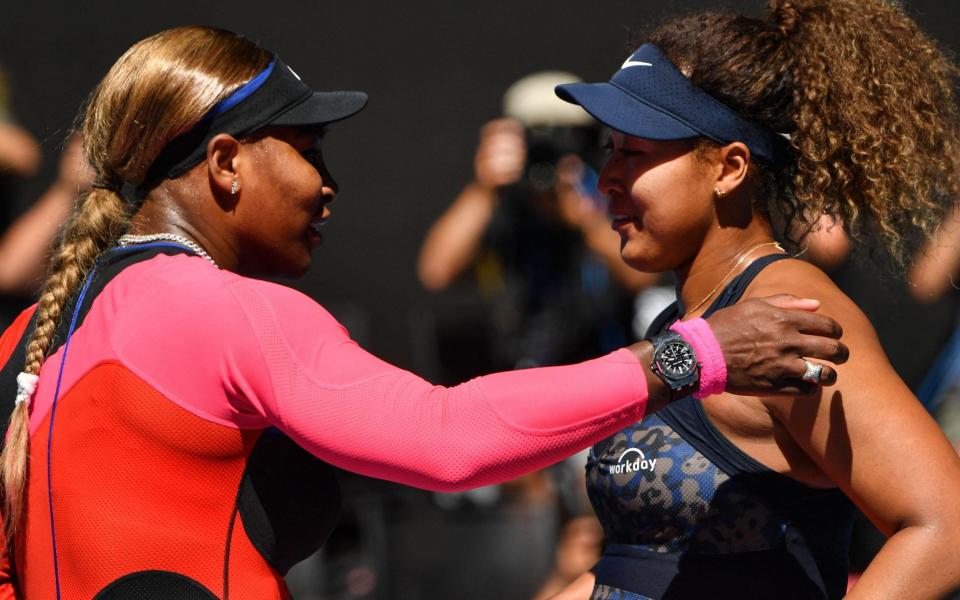Why top women's players want to leave tennis

After a bruising 2022 when Serena Williams and Ashleigh Barty retired, the new Women’s Tennis Association season got off to the worst possible start when Naomi Osaka withdrew from the Australian Open.
The news fits with long-swirling rumours that Osaka has given up training and may never even play competitive tennis again. Worse still, it underlines the impression that the modern tour is too uncongenial a lifestyle for many leading women. As soon as they can afford to get off the carousel, they do.
Obviously Osaka does not need to play to earn a living. According to Forbes, she made $58 million (£47.5 million) in off-court earnings last year, putting her fourth behind only Roger Federer, LeBron James and Tiger Woods among the world’s top athletes. On the court, she made a fraction of that: just $1.2 million.
Rivalries at the top of women’s tennis – or a lack thereof – have been cited by some as contributing to the dwindling motivation players such as Osaka and Barty feel when they reach the world No 1 spot in their early twenties.
While the Williams sisters are an exception – with Serena quitting at 40 and Venus still picking up the odd win at 42 – there is anecdotal evidence that women find the relentless calendar less appealing than some of their male counterparts do.
Perhaps this is unsurprising, as the international tour was essentially developed by men for men, with Billie Jean King and her accomplices gradually building up a mirror image in the 1970s.
In those days, a sense of camaraderie animated the WTA locker-room; a scrappy group of players fighting together for recognition. Nowadays, though, the impression is of much more atomised and isolated lifestyles in which few players mix beyond their individual team of coaches and trainers.
They are far better remunerated now, by a WTA Tour which has become comfortably the leading women’s sports organisation in the world. But recent events suggest larger incomes for the very best players could equate to shorter careers.

Netflix’s new fly-on-the-wall documentary series, Break Point, offers a small sample, but supports the argument that women find it harder to process defeats – or at least vocalise these challenges more. The series also highlights the frustration of those – such as world No 2 Ons Jabeur – who would like to start a family if it did not mean taking an extended break from the tour. Paula Badosa also admits that poor mental health has been a regular part of her tennis life, something Osaka and Barty previously spoken about during their playing careers too.
Over the five episodes to be released on Friday, it is not only the women who express angst; Nick Kyrgios also speaks of the burden of expectation that left him “drinking every single night” in his younger years. But the likes of Matteo Berrettini and Félix Auger-Aliassime seem at home in their environment, while all four women featured express misgivings.
Indeed, Berrettini and his girlfriend at the time, Ajla Tomljanovic, are captured in the midst of a revealing conversation at the 2022 Australian Open, after Tomljanovic had suffered a soul-crushing defeat at Badosa’s hands. In the corridor afterwards, a tearful Tomljanovic told her coach, “What’s the point of being out there if I don’t think I can win? I just retire. It’s screwing up my mind.”
Later, in their hotel room, Berrettini explains how he tells himself that all his experiences – even the negative ones – will eventually be helpful. “You do that better than me,” she says.
Dealing with the almost weekly losses, family planning and the travel schedule are all identified as hurdles for female players. But the WTA vice-president of mental health and wellness, Becky Ahlgren Bedics, warns that stereotypes can creep into this portrayal too, and external factors such as the pandemic are just as important to the female players’ ability to handle touring life.
“Did they ask the men about their family concern? I don’t know,” Ahlgren Bedics says. “I think in women’s sports, that’s something that we always have to think about. The travel can be gruelling. Tennis being an individual performance sport certainly has that element when you are on the court on your own and there’s no hiding.”
Ahlgren Bedics describes “a very healthy usage rate” of mental health services on the tour, with her four-person staff available either at events or remotely for players to book appointments with wherever they are. World No 1 Iga Swiatek – the most dominant force in the sport since Osaka and Barty – has spoken about the benefits of having her sports psychologist, Daria Abramowicz, as a travelling member of her team. But Swiatek is not bullet-proof either: she crumbled into tears court-side at the United Cup last week, when she suffered a rare straight-sets loss to Jessica Pegula.

Perhaps – as in Break Point – the women are just better at showing and expressing their vulnerabilities. But with a player of Osaka’s talent and profile seemingly opting out of tennis, it feels like something needs to change to avoid further losses.
Increasing the number of women coaches and support staff at all levels of tennis could help. But a recent study by Leeds Beckett University, which profiled eight female professional tennis coaches, found that the traditional expectation for coaches to dedicate themselves 100 per cent to the service of their players can work as a barrier for women. The large majority of top women players travel with all-male teams, which only adds to the impression that tennis continues to be an environment men thrive in more easily.
Another possible solution could be mixing up the tennis calendar to include more team tennis events. King’s World TeamTennis league, launched in 1973, runs for two weeks in the US and has attracted top players over the years. The Davis Cup and BJK Cup alongside the new United Cup offer similar breaks in the schedule. They can be fun antidotes to the intensity and solitude of traditional tour weeks.
Whatever the solution, it is needed quickly, if women’s tennis is to stop the exodus of its best talents.

